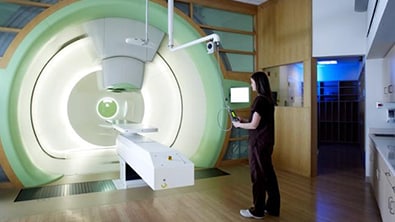
Proton Therapy reduces the risk of a second cancer diagnosis by 69% versus other forms of radiation treatment according to a paper recently released by a team from Stanford University.
The study looked at 450,373 patients in the National Cancer Database who received either 3D conformal radiation therapy (3DCRT), Intensity Modulated Radiation Therapy (IMRT), or Proton Beam Radiation Therapy (PBRT). The median follow-up time on the study was 5.1 years after radiation therapy treatment with.
3DCRT and IMRT are both X-Ray based radiation treatment methods while proton therapy utilizes proton particles to damage the DNA of cancer cells ultimately destroying the tumor.
The results were generally consistent across 9 tumor types that included head and neck, gastrointestinal (GI), gynecologic, lymphoma, lung, prostate, breast, bone/soft tissue and brain/central nervous system tumors.
Proton Therapy is a form of radiation treatment for many cancers that has been in use since 1954. Over 200,000 patients have successfully been treated worldwide with protons. There are currently 33 facilities across the United States using proton therapy to treat cancer including many of the country’s top cancer centers such as MD Anderson, Mayo Clinic, Harvard, Memorial Sloan Kettering, and Johns Hopkins.
Dr. John Chang, Medical Director at Oklahoma Proton Center, the nation’s 6th proton center, is familiar with the clinical benefits of proton therapy having treated with protons for the past decade.
“The results of the Stanford Study are not surprising,” said Dr. Chang. “Protons are simply more precise than even the latest types of X-Ray treatment such as IMRT and deliver less radiation to healthy tissue, so there are going to typically be fewer long-term side effects for patients.”

Dr. Chang encouraged any patient prescribed radiation as a treatment option to reach out to a proton center and speak with a physician there to find out how proton therapy could benefit them.
“Too often I see patients rush into the first treatment option presented to them without taking the time to consider all of the options available,” said Dr. Chang. “Patients should be their own best advocates and seek advice from experts in different types of treatment before making a decision. We encourage that of any patient coming to Oklahoma Proton Center.”
Historically insurance coverage has been an issue for some patients seeking proton therapy as a treatment option. However, as the clinical evidence has continued to show the benefits of proton therapy, insurance companies have expanded coverage policies to give more patients access to treatment. Additionally, Medicare continues to provide very broad coverage for protons as it has done since the late 1990s.
Patients with questions about proton therapy or who want to see how a proton therapy treatment could be different than IMRT or 3DCRT for their cancer can reach out to Oklahoma Proton Center at (405) 773-6700 or contact them via their website at www.okcproton.com. For patients who are out of town, Oklahoma Proton Center offers a Telehealth visit option.
